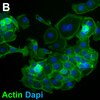Circadian Proteins CLOCK and BMAL1 in the Chromatoid Body, a RNA Processing Granule of Male Germ Cells.
Rita L Peruquetti,Sara de Mateo,Paolo Sassone-Corsi
PloS one
7
2011
Abstract anzeigen
Spermatogenesis is a complex differentiation process that involves genetic and epigenetic regulation, sophisticated hormonal control, and extensive structural changes in male germ cells. RNA nuclear and cytoplasmic bodies appear to be critical for the progress of spermatogenesis. The chromatoid body (CB) is a cytoplasmic organelle playing an important role in RNA post-transcriptional and translation regulation during the late steps of germ cell differentiation. The CB is also important for fertility determination since mutations of genes encoding its components cause infertility by spermatogenesis arrest. Targeted ablation of the Bmal1 and Clock genes, which encode central regulators of the circadian clock also result in fertility defects caused by problems other than spermatogenesis alterations. We show that the circadian proteins CLOCK and BMAL1 are localized in the CB in a stage-specific manner of germ cells. Both BMAL1 and CLOCK proteins physically interact with the ATP-dependent DEAD-box RNA helicase MVH (mouse VASA homolog), a hallmark component of the CB. BMAL1 is differentially expressed during the spermatogenic cycle of seminiferous tubules, and Bmal1 and Clock deficient mice display significant CB morphological alterations due to BMAL1 ablation or low expression. These findings suggest that both BMAL1 and CLOCK contribute to CB assembly and physiology, raising questions on the role of the circadian clock in reproduction and on the molecular function that CLOCK and BMAL1 could potentially have in the CB assembly and physiology. | 22900038
 |
Pyrrolidine dithiocarbamate down-regulates vascular matrix metalloproteinases and ameliorates vascular dysfunction and remodelling in renovascular hypertension.
S B A Cau,D A Guimaraes,E Rizzi,C S Ceron,L L Souza,C R Tirapelli,R F Gerlach,J E Tanus-Santos
British journal of pharmacology
164
2010
Abstract anzeigen
Mounting evidence implicates matrix metalloproteinase (MMP) in the vascular dysfunction and remodelling associated with hypertension. We tested the hypothesis that treatment with pyrrolidine dithiocarbamate (PDTC), which interferes with NF-κB-induced MMPs gene transcription, could exert antihypertensive effects, prevent MMP-2 and MMP-9 up-regulation, and protect against the functional alterations and vascular remodelling of two-kidney, one clip (2K1C) hypertension. | 21434884
 |
Comparative study on antioxidant effects and vascular matrix metalloproteinase-2 downregulation by dihydropyridines in renovascular hypertension.
Diogo M O Marçal,Elen Rizzi,Alisson Martins-Oliveira,Carla S Ceron,Danielle A Guimaraes,Raquel F Gerlach,Jose E Tanus-Santos
Naunyn-Schmiedeberg's archives of pharmacology
383
2010
Abstract anzeigen
The vascular remodeling associated with hypertension involves oxidative stress and enhanced matrix metalloproteinases (MMPs) expression/activity, especially MMP-2. While previous work showed that lercanidipine, a third-generation dihydropyridine calcium channel blocker (CCB), attenuated the oxidative stress and increased MMP-2 expression/activity in two-kidney, one-clip (2K1C) hypertension, no previous study has examined whether first- or second-generation dihydropyridines produce similar effects. We compared the effects of nifedipine, nimodipine, and amlodipine on 2K1C hypertension-induced changes in systolic blood pressure (SBP), vascular remodeling, oxidative stress, and MMPs levels/activity. Sham-operated and 2K1C rats were treated with water, nifedipine 10 mg/kg/day, nimodipine 15 mg/kg/day, or amlodipine 10 mg/kg/day by gavage, starting 3 weeks after hypertension was induced. SBP was monitored weekly. After 6 weeks of treatment, quantitative morphometry of structural changes in the aortic wall was studied in hematoxylin/eosin-stained sections. Aortic and systemic reactive oxygen species levels were measured by using dihydroethidine and thiobarbituric acid-reactive substances (TBARs), respectively. Aortic MMP-2 levels and activity were determined by gelatin zymography, in situ zymography, and immunofluorescence. Nifedipine, nimodipine, or amlodipine attenuated the increases in SBP in hypertensive rats by approximately 17% (P < 0.05) and prevented vascular hypertrophy (P < 0.05). These CCBs blunted 2K1C-induced increases in vascular oxidative stress and plasma TBARs concentrations (P < 0.05). All dihydropyridines attenuated the increases in aortic MMP-2 levels and activity associated with 2K1C hypertension. These findings suggest lack of superiority of one particular dihydropyridine, at least with respect to antioxidant effects, MMPs downregulation, and inhibition of vascular remodeling in hypertension. | 21058008
 |
Doxycycline dose-dependently inhibits MMP-2-mediated vascular changes in 2K1C hypertension.
Danielle A Guimaraes,Elen Rizzi,Carla S Ceron,Alisson M Oliveira,Diogo M Oliveira,Michele M Castro,Carlos R Tirapelli,Raquel F Gerlach,Jose E Tanus-Santos
Basic & clinical pharmacology & toxicology
108
2010
Abstract anzeigen
Hypertension induces vascular alterations that are associated with up-regulation of matrix metalloproteinases (MMPs). While these alterations may be blunted by doxycycline, a non-selective MMPs inhibitor, no previous study has examined the effects of different doses of doxycycline on these alterations. This is important because doxycycline has been used at sub-antimicrobial doses, and the use of lower doses may prevent the emergence of antibiotic-resistant microorganisms. We studied the effects of doxycycline at 3, 10 and 30 mg/kg per day on the vascular alterations found in the rat two kidney-one clip (2K1C) hypertension (n = 20 rats/group). Systolic blood pressure (SBP) was monitored during 4 weeks of treatment. We assessed endothelium-dependent and independent relaxations. Quantitative morphometry of structural changes in the aortic wall was studied, and aortic MMP-2 levels/proteolytic activity were determined by gelatin and in situ zymography, respectively. All treatments attenuated the increases in SBP in hypertensive rats (195.4 ± 3.9 versus 177.2 ± 6.2, 176.3 ± 4.5, and 173 ± 5.1 mmHg in 2K1C hypertensive rats treated with vehicle, or doxycycline at 3, 10, 30 mg/kg per day, respectively (all p < 0.01). However, only the highest dose prevented 2K1C-induced reduction in endothelium-dependent vasorelaxation (p < 0.05), vascular hypertrophy and increases in MMP-2 levels (all p < 0.05). In conclusion, our results suggest that relatively lower doses of doxycycline do not attenuate the vascular alterations found in the 2K1C hypertension model, and only the highest dose of doxycycline affects MMPs and vascular structure. Our results support the idea that the effects of doxycycline on MMP-2 and vascular structure are pressure independent. | 21176109
 |
Matrix metalloproteinase inhibition improves cardiac dysfunction and remodeling in 2-kidney, 1-clip hypertension.
Elen Rizzi,Michele M Castro,Cibele M Prado,Carlos A Silva,Rubens Fazan,Marcos A Rossi,Jose E Tanus-Santos,Raquel Fernanda Gerlach
Journal of cardiac failure
16
2009
Abstract anzeigen
Enhanced cardiac matrix metalloproteinase activity (MMPs) has been associated with ventricular remodeling and cardiac dysfunction. It is unknown whether MMPs contribute to systolic/diastolic dysfunction and compensatory remodeling in 2-kidney, 1-clip (2K1C) hypertensive rats. To test this hypothesis, we used 2K1C rats after 2 weeks of surgery treated or not with a nonspecific inhibitor of MMPs (doxycycline). | 20610236
 |
MiR-128 up-regulation inhibits Reelin and DCX expression and reduces neuroblastoma cell motility and invasiveness.
C Evangelisti, MC Florian, I Massimi, C Dominici, G Giannini, S Galardi, MC Bue, S Massalini, HP McDowell, E Messi, A Gulino, MG Farace, SA Ciafre
The FASEB journal : official publication of the Federation of American Societies for Experimental Biology
23
4276-87
2009
Abstract anzeigen
MicroRNAs are a class of sophisticated regulators of gene expression, acting as post-transcriptional inhibitors that recognize their target mRNAs through base pairing with short regions along the 3'UTRs. Several microRNAs are tissue specific, suggesting a specialized role in tissue differentiation or maintenance, and quite a few are critically involved in tumorigenesis. We studied miR-128, a brain-enriched microRNA, in retinoic acid-differentiated neuroblastoma cells, and we found that this microRNA is up-regulated in treated cells, where it down-modulates the expression of two proteins involved in the migratory potential of neural cells: Reelin and DCX. Consistently, miR-128 ectopic overexpression suppressed Reelin and DCX, whereas the LNA antisense-mediated miR-128 knockdown caused the two proteins to increase. Ectopic miR-128 overexpression reduced neuroblastoma cell motility and invasiveness, and impaired cell growth. Finally, the analysis of a small series of primary human neuroblastomas showed an association between high levels of miR-128 expression and favorable features, such as favorable Shimada category or very young age at diagnosis. Thus, we provide evidence for a role for miR-128 in the molecular events modulating neuroblastoma progression and aggressiveness. | 19713529
 |
miR-221 and miR-222 expression affects the proliferation potential of human prostate carcinoma cell lines by targeting p27Kip1.
Galardi, S; Mercatelli, N; Giorda, E; Massalini, S; Frajese, GV; Ciafrè, SA; Farace, MG
The Journal of biological chemistry
282
23716-24
2007
Abstract anzeigen
MicroRNAs are short regulatory RNAs that negatively modulate protein expression at a post-transcriptional level and are deeply involved in the pathogenesis of several types of cancers. Here we show that miR-221 and miR-222, encoded in tandem on chromosome X, are overexpressed in the PC3 cellular model of aggressive prostate carcinoma, as compared with LNCaP and 22Rv1 cell line models of slowly growing carcinomas. In all cell lines tested, we show an inverse relationship between the expression of miR-221 and miR-222 and the cell cycle inhibitor p27(Kip1). We recognize two target sites for the microRNAs in the 3' untranslated region of p27 mRNA, and we show that miR-221/222 ectopic overexpression directly results in p27 down-regulation in LNCaP cells. In those cells, we demonstrate that the ectopic overexpression of miR-221/222 strongly affects their growth potential by inducing a G(1) to S shift in the cell cycle and is sufficient to induce a powerful enhancement of their colony-forming potential in soft agar. Consistently, miR-221 and miR-222 knock-down through antisense LNA oligonucleotides increases p27(Kip1) in PC3 cells and strongly reduces their clonogenicity in vitro. Our results suggest that miR-221/222 can be regarded as a new family of oncogenes, directly targeting the tumor suppressor p27(Kip1), and that their overexpression might be one of the factors contributing to the oncogenesis and progression of prostate carcinoma through p27(Kip1) down-regulation. | 17569667
 |
Neuron-glia communication: metallothionein expression is specifically up-regulated by astrocytes in response to neuronal injury.
Roger S Chung, Paul A Adlard, Justin Dittmann, James C Vickers, Meng Inn Chuah, Adrian K West
Journal of neurochemistry
88
454-61
2004
Abstract anzeigen
Recent data suggests that metallothioneins (MTs) are major neuroprotective proteins within the CNS. In this regard, we have recently demonstrated that MT-IIA (the major human MT-I/-II isoform) promotes neural recovery following focal cortical brain injury. To further investigate the role of MTs in cortical brain injury, MT-I/-II expression was examined in several different experimental models of cortical neuron injury. While MT-I/-II immunoreactivity was not detectable in the uninjured rat neocortex, by 4 days, following a focal cortical brain injury, MT-I/-II was found in astrocytes aligned along the injury site. At latter time points, astrocytes, at a distance up to several hundred microns from the original injury tract, were MT-I/-II immunoreactive. Induced MT-I/-II was found both within the cell body and processes. Using a cortical neuron/astrocyte co-culture model, we observed a similar MT-I/-II response following in vitro injury. Intriguingly, scratch wound injury in pure astrocyte cultures resulted in no change in MT-I/-II expression. This suggests that MT induction was specifically elicited by neuronal injury. Based upon recent reports indicating that MT-I/-II are major neuroprotective proteins within the brain, our results provide further evidence that MT-I/-II plays an important role in the cellular response to neuronal injury. | 14690533
 |





















